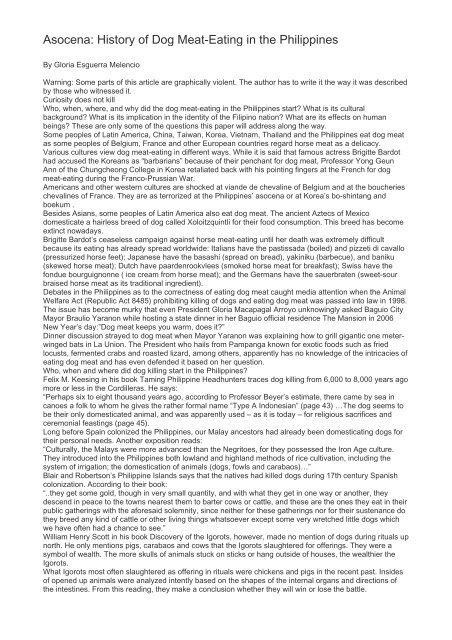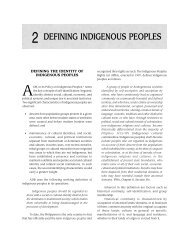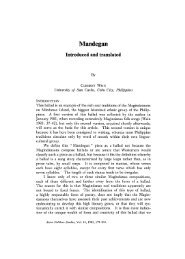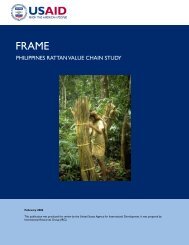Asocena: History of Dog Meat-Eating in the ... - Philippine Culture
Asocena: History of Dog Meat-Eating in the ... - Philippine Culture
Asocena: History of Dog Meat-Eating in the ... - Philippine Culture
Create successful ePaper yourself
Turn your PDF publications into a flip-book with our unique Google optimized e-Paper software.
<strong>Asocena</strong>: <strong>History</strong> <strong>of</strong> <strong>Dog</strong> <strong>Meat</strong>-<strong>Eat<strong>in</strong>g</strong> <strong>in</strong> <strong>the</strong> Philipp<strong>in</strong>esBy Gloria Esguerra MelencioWarn<strong>in</strong>g: Some parts <strong>of</strong> this article are graphically violent. The author has to write it <strong>the</strong> way it was describedby those who witnessed it.Curiosity does not killWho, when, where, and why did <strong>the</strong> dog meat-eat<strong>in</strong>g <strong>in</strong> <strong>the</strong> Philipp<strong>in</strong>es start? What is its culturalbackground? What is its implication <strong>in</strong> <strong>the</strong> identity <strong>of</strong> <strong>the</strong> Filip<strong>in</strong>o nation? What are its effects on humanbe<strong>in</strong>gs? These are only some <strong>of</strong> <strong>the</strong> questions this paper will address along <strong>the</strong> way.Some peoples <strong>of</strong> Lat<strong>in</strong> America, Ch<strong>in</strong>a, Taiwan, Korea, Vietnam, Thailand and <strong>the</strong> Philipp<strong>in</strong>es eat dog meatas some peoples <strong>of</strong> Belgium, France and o<strong>the</strong>r European countries regard horse meat as a delicacy.Various cultures view dog meat-eat<strong>in</strong>g <strong>in</strong> different ways. While it is said that famous actress Brigitte Bardothad accused <strong>the</strong> Koreans as “barbarians” because <strong>of</strong> <strong>the</strong>ir penchant for dog meat, Pr<strong>of</strong>essor Yong GeunAnn <strong>of</strong> <strong>the</strong> Chungcheong College <strong>in</strong> Korea retaliated back with his po<strong>in</strong>t<strong>in</strong>g f<strong>in</strong>gers at <strong>the</strong> French for dogmeat-eat<strong>in</strong>g dur<strong>in</strong>g <strong>the</strong> Franco-Prussian War.Americans and o<strong>the</strong>r western cultures are shocked at viande de cheval<strong>in</strong>e <strong>of</strong> Belgium and at <strong>the</strong> boucheriescheval<strong>in</strong>es <strong>of</strong> France. They are as terrorized at <strong>the</strong> Philipp<strong>in</strong>es’ asocena or at Korea’s bo-sh<strong>in</strong>tang andboekum .Besides Asians, some peoples <strong>of</strong> Lat<strong>in</strong> America also eat dog meat. The ancient Aztecs <strong>of</strong> Mexicodomesticate a hairless breed <strong>of</strong> dog called Xoloitzqu<strong>in</strong>tli for <strong>the</strong>ir food consumption. This breed has becomeext<strong>in</strong>ct nowadays.Brigitte Bardot’s ceaseless campaign aga<strong>in</strong>st horse meat-eat<strong>in</strong>g until her death was extremely difficultbecause its eat<strong>in</strong>g has already spread worldwide: Italians have <strong>the</strong> pastissada (boiled) and pizzeti di cavallo(pressurized horse feet); Japanese have <strong>the</strong> basashi (spread on bread), yak<strong>in</strong>iku (barbecue), and baniku(skewed horse meat); Dutch have paardenrookvlees (smoked horse meat for breakfast); Swiss have <strong>the</strong>fondue bourguignonne ( ice cream from horse meat); and <strong>the</strong> Germans have <strong>the</strong> sauerbraten (sweet-sourbraised horse meat as its traditional <strong>in</strong>gredient).Debates <strong>in</strong> <strong>the</strong> Philipp<strong>in</strong>es as to <strong>the</strong> correctness <strong>of</strong> eat<strong>in</strong>g dog meat caught media attention when <strong>the</strong> AnimalWelfare Act (Republic Act 8485) prohibit<strong>in</strong>g kill<strong>in</strong>g <strong>of</strong> dogs and eat<strong>in</strong>g dog meat was passed <strong>in</strong>to law <strong>in</strong> 1998.The issue has become murky that even President Gloria Macapagal Arroyo unknow<strong>in</strong>gly asked Baguio CityMayor Braulio Yaranon while host<strong>in</strong>g a state d<strong>in</strong>ner <strong>in</strong> her Baguio <strong>of</strong>ficial residence The Mansion <strong>in</strong> 2006New Year’s day:”<strong>Dog</strong> meat keeps you warm, does it?”D<strong>in</strong>ner discussion strayed to dog meat when Mayor Yaranon was expla<strong>in</strong><strong>in</strong>g how to grill gigantic one meterw<strong>in</strong>gedbats <strong>in</strong> La Union. The President who hails from Pampanga known for exotic foods such as friedlocusts, fermented crabs and roasted lizard, among o<strong>the</strong>rs, apparently has no knowledge <strong>of</strong> <strong>the</strong> <strong>in</strong>tricacies <strong>of</strong>eat<strong>in</strong>g dog meat and has even defended it based on her question.Who, when and where did dog kill<strong>in</strong>g start <strong>in</strong> <strong>the</strong> Philipp<strong>in</strong>es?Felix M. Kees<strong>in</strong>g <strong>in</strong> his book Tam<strong>in</strong>g Philipp<strong>in</strong>e Headhunters traces dog kill<strong>in</strong>g from 6,000 to 8,000 years agomore or less <strong>in</strong> <strong>the</strong> Cordilleras. He says:“Perhaps six to eight thousand years ago, accord<strong>in</strong>g to Pr<strong>of</strong>essor Beyer’s estimate, <strong>the</strong>re came by sea <strong>in</strong>canoes a folk to whom he gives <strong>the</strong> ra<strong>the</strong>r formal name “Type A Indonesian” (page 43) …The dog seems tobe <strong>the</strong>ir only domesticated animal, and was apparently used – as it is today – for religious sacrifices andceremonial feast<strong>in</strong>gs (page 45).Long before Spa<strong>in</strong> colonized <strong>the</strong> Philipp<strong>in</strong>es, our Malay ancestors had already been domesticat<strong>in</strong>g dogs for<strong>the</strong>ir personal needs. Ano<strong>the</strong>r exposition reads:“Culturally, <strong>the</strong> Malays were more advanced than <strong>the</strong> Negritoes, for <strong>the</strong>y possessed <strong>the</strong> Iron Age culture.They <strong>in</strong>troduced <strong>in</strong>to <strong>the</strong> Philipp<strong>in</strong>es both lowland and highland methods <strong>of</strong> rice cultivation, <strong>in</strong>clud<strong>in</strong>g <strong>the</strong>system <strong>of</strong> irrigation; <strong>the</strong> domestication <strong>of</strong> animals (dogs, fowls and carabaos)…”Blair and Robertson’s Philipp<strong>in</strong>e Islands says that <strong>the</strong> natives had killed dogs dur<strong>in</strong>g 17th century Spanishcolonization. Accord<strong>in</strong>g to <strong>the</strong>ir book:“..<strong>the</strong>y get some gold, though <strong>in</strong> very small quantity, and with what <strong>the</strong>y get <strong>in</strong> one way or ano<strong>the</strong>r, <strong>the</strong>ydescend <strong>in</strong> peace to <strong>the</strong> towns nearest <strong>the</strong>m to barter cows or cattle, and <strong>the</strong>se are <strong>the</strong> ones <strong>the</strong>y eat <strong>in</strong> <strong>the</strong>irpublic ga<strong>the</strong>r<strong>in</strong>gs with <strong>the</strong> aforesaid solemnity, s<strong>in</strong>ce nei<strong>the</strong>r for <strong>the</strong>se ga<strong>the</strong>r<strong>in</strong>gs nor for <strong>the</strong>ir sustenance do<strong>the</strong>y breed any k<strong>in</strong>d <strong>of</strong> cattle or o<strong>the</strong>r liv<strong>in</strong>g th<strong>in</strong>gs whatsoever except some very wretched little dogs whichwe have <strong>of</strong>ten had a chance to see.”William Henry Scott <strong>in</strong> his book Discovery <strong>of</strong> <strong>the</strong> Igorots, however, made no mention <strong>of</strong> dogs dur<strong>in</strong>g rituals upnorth. He only mentions pigs, carabaos and cows that <strong>the</strong> Igorots slaughtered for <strong>of</strong>fer<strong>in</strong>gs. They were asymbol <strong>of</strong> wealth. The more skulls <strong>of</strong> animals stuck on sticks or hang outside <strong>of</strong> houses, <strong>the</strong> wealthier <strong>the</strong>Igorots.What Igorots most <strong>of</strong>ten slaughtered as <strong>of</strong>fer<strong>in</strong>g <strong>in</strong> rituals were chickens and pigs <strong>in</strong> <strong>the</strong> recent past. Insides<strong>of</strong> opened up animals were analyzed <strong>in</strong>tently based on <strong>the</strong> shapes <strong>of</strong> <strong>the</strong> <strong>in</strong>ternal organs and directions <strong>of</strong><strong>the</strong> <strong>in</strong>test<strong>in</strong>es. From this read<strong>in</strong>g, <strong>the</strong>y make a conclusion whe<strong>the</strong>r <strong>the</strong>y will w<strong>in</strong> or lose <strong>the</strong> battle.
However, Filip<strong>in</strong>o American Historical Society found<strong>in</strong>g president Dr. Virgilio R. Pilapil wrote <strong>in</strong> his essay<strong>Dog</strong>town USA: An Igorot Legacy <strong>in</strong> <strong>the</strong> Midwest disclosed how <strong>the</strong> Igorots started to be known to eat dogmeat <strong>in</strong> St. Louis World’s Fair 1904.This world fair was also called Lousiana Purchase Exposition to commemorate <strong>the</strong> 100th anniversary <strong>of</strong>USA’s purchase <strong>of</strong> Lousiana from France. It was <strong>the</strong> biggest and longest <strong>of</strong> all expositions that occurred <strong>in</strong><strong>the</strong> world dur<strong>in</strong>g that time. Jo<strong>in</strong><strong>in</strong>g <strong>the</strong> seven-month exposition were 45 countries with representatives from50 tribes who lived <strong>in</strong> 1,500 build<strong>in</strong>gs that were built on 1, 275 acres <strong>of</strong> land for six years.Dr. Pilapil wrote that 1,100 Filip<strong>in</strong>os jo<strong>in</strong>ed <strong>the</strong> Philipp<strong>in</strong>e Exhibit. Members <strong>of</strong> <strong>the</strong> Philipp<strong>in</strong>e delegation wereIgorots who wore beautifully colored G-str<strong>in</strong>gs and later became known not only for <strong>the</strong>ir exotic dances with<strong>the</strong>ir gong beats but for <strong>the</strong>ir believed habit <strong>of</strong> eat<strong>in</strong>g dog meat. Dr Pilapil fur<strong>the</strong>r discloses:“The head-hunt<strong>in</strong>g, dog-eat<strong>in</strong>g Igorots were <strong>the</strong> greatest attraction at <strong>the</strong> Philipp<strong>in</strong>e Exhibit, not only because<strong>of</strong> <strong>the</strong>ir novelty, <strong>the</strong> scanty dress<strong>in</strong>g <strong>of</strong> <strong>the</strong> males and <strong>the</strong>ir daily danc<strong>in</strong>g to <strong>the</strong> tom-tom beats, but alsobecause <strong>of</strong> <strong>the</strong>ir appetite for dog meat which is a normal part <strong>of</strong> <strong>the</strong>ir diet.The city <strong>of</strong> St. Louis provided <strong>the</strong>m a supply <strong>of</strong> dogs at <strong>the</strong> agreed amount <strong>of</strong> 20 dogs a week, but this didnot appear to be sufficient, as <strong>the</strong>y had also encouraged local people to br<strong>in</strong>g <strong>the</strong>m dogs which <strong>the</strong>y boughtto supplement <strong>the</strong>ir daily needs.The poach<strong>in</strong>g <strong>of</strong> dogs became so common <strong>in</strong> <strong>the</strong> area near <strong>the</strong> Igorot Village such that <strong>the</strong> neighborhoodwas warned to watch for <strong>the</strong>ir dogs; even <strong>the</strong>n, many dogs were disappear<strong>in</strong>g <strong>in</strong> this neighborhood, anger<strong>in</strong>gand upsett<strong>in</strong>g many people.There were obviously many people who objected to <strong>the</strong> supply<strong>in</strong>g <strong>of</strong> dogs to <strong>the</strong> Igorots, particularly <strong>the</strong> St.Louis Women’s Humane Society, but <strong>the</strong>re were also many people, perhaps much more, who sympathizedwith <strong>the</strong> Igorot’s need for dog meat.As one Missourian, who had been to <strong>the</strong> Philipp<strong>in</strong>es and realized <strong>the</strong> difficulty <strong>of</strong> not be<strong>in</strong>g able to eat <strong>the</strong>food that one is used to, noted, “Every dog has his day, and every man his meat.” He donated 200 fatMissouri dogs to <strong>the</strong> Igorots!”After this world fair experience, a small village <strong>in</strong> <strong>the</strong> sou<strong>the</strong>rn part <strong>of</strong> Forest Park where <strong>the</strong> exposition <strong>in</strong> St.Louis, Missouri was held came to be known as <strong>Dog</strong>town. This was later burned but ano<strong>the</strong>r place, also <strong>in</strong> St.Louis, was renamed <strong>Dog</strong>town.High school students <strong>of</strong> Wydon Middle School <strong>in</strong> <strong>Dog</strong>town baptized <strong>the</strong>ir annual yearbook as <strong>the</strong> IgorroteYearbook <strong>in</strong> 1937. The Igorrote Football Team was also formed <strong>in</strong> 1974.Dr. Pilapil likewise revealed that <strong>the</strong> word hotdog came from dog meat eat<strong>in</strong>g <strong>of</strong> <strong>the</strong> Igorots dur<strong>in</strong>g <strong>the</strong> worldfair. He fur<strong>the</strong>r states <strong>in</strong> his essay:“It first appeared at <strong>the</strong> St. Louis World’s Fair among several o<strong>the</strong>r firsts such as <strong>the</strong> first ice cream cone, <strong>the</strong>first iced tea, <strong>the</strong> first Olympic Games <strong>in</strong> America (Third World Olympics), <strong>the</strong> first sliced bread, and <strong>the</strong> firstco<strong>in</strong> changer. Even though many people will claim that <strong>the</strong> hot dog has been known for a long time before<strong>the</strong> St. Louis World’s Fair, it is not so.What was known, even as early as <strong>the</strong> late Middle Ages <strong>in</strong> Europe, was <strong>the</strong> mak<strong>in</strong>g <strong>of</strong> sausages and it was aGerman butcher, Johann Georg Lahner, who developed prototypes <strong>in</strong> Frankfurt and later <strong>in</strong> Vienna, thatwere called frankfurter and wiener.These franks, along with o<strong>the</strong>r types <strong>of</strong> sausages, were later brought to America by German immigrants <strong>in</strong><strong>the</strong> n<strong>in</strong>eteenth century. In New York, <strong>in</strong> 1900, a concessionaire sold a Lahner-type frank tie called a“Dachsund sausage” that was later sketched by a cartoonist <strong>in</strong> <strong>the</strong> form <strong>of</strong> a dachsund <strong>in</strong> a roll.However, it was not until <strong>the</strong> St. Louis World’s Fair that a sausage-on-a-bun was made up to be called <strong>the</strong>“hot dog” for <strong>the</strong> first time. It is evident that sausages were known for a long time and were called by variousnames, but it was <strong>the</strong> St. Louis World’s Fair that gave <strong>the</strong> name “hot dog” to America.Why was it called a hot dog <strong>in</strong>stead <strong>of</strong> <strong>the</strong> already known names with which it has been associated? Was itbecause <strong>the</strong> sausage was made <strong>of</strong> dog meat? No, certa<strong>in</strong>ly not. The American public would just be horrifiedat <strong>the</strong> time to th<strong>in</strong>k <strong>of</strong> eat<strong>in</strong>g dog meat.Was it <strong>the</strong>n because <strong>the</strong> sausage was crafted to look like a dog or <strong>the</strong> bun shaped <strong>in</strong>to <strong>the</strong> form <strong>of</strong> a dog?Aga<strong>in</strong>, <strong>the</strong> answer is no. Then why was it called a hot dog when <strong>the</strong>re is noth<strong>in</strong>g that could be associatedwith a dog <strong>in</strong> a hot dog? To me <strong>the</strong> answer is simple.We have said earlier that St. Louis World’s Fair was <strong>the</strong> greatest <strong>of</strong> expositions that <strong>the</strong>re ever was. We alsosaid that <strong>the</strong> Philipp<strong>in</strong>e Exhibit was <strong>the</strong> largest one at <strong>the</strong> Fair and was considered as a Fair with<strong>in</strong> a Fair.Then we also said that <strong>the</strong> Igorots were <strong>the</strong> top attraction at <strong>the</strong> Philipp<strong>in</strong>e exhibit, not only because <strong>of</strong> <strong>the</strong>irprimitive skimpy attire and <strong>the</strong>ir constant danc<strong>in</strong>g, but also because <strong>of</strong> <strong>the</strong>ir dog-eat<strong>in</strong>g custom.The city supplied <strong>the</strong>m with dogs and <strong>the</strong>y also bought dogs from <strong>the</strong> neighborhood, <strong>in</strong> addition to receiv<strong>in</strong>gdonations <strong>of</strong> dogs from o<strong>the</strong>r sources, for <strong>the</strong>ir food supply. The people <strong>in</strong> <strong>the</strong> neighborhood near <strong>the</strong> IgorotVillage were concerned, upset, and angered at times because <strong>of</strong> <strong>the</strong> disappearance <strong>of</strong> dogs <strong>in</strong> <strong>the</strong>irneighborhood.The people <strong>in</strong> <strong>the</strong> city <strong>of</strong> St. Louis and surround<strong>in</strong>g areas were engaged <strong>in</strong> an on-go<strong>in</strong>g debate about <strong>the</strong> use<strong>of</strong> dogs by <strong>the</strong> Igorots. This was evident <strong>in</strong> <strong>the</strong> newspapers <strong>of</strong> <strong>the</strong> day which carried regular news, letters,and comments concern<strong>in</strong>g <strong>the</strong> eat<strong>in</strong>g <strong>of</strong> dogs by <strong>the</strong> Igorots.In short, <strong>the</strong> atmosphere <strong>in</strong> and around <strong>the</strong> Fair and <strong>in</strong> <strong>the</strong> newspaper media was saturated by <strong>the</strong> thoughts<strong>of</strong> <strong>the</strong> dog-eat<strong>in</strong>g custom <strong>of</strong> <strong>the</strong> Igorots. Their dog-eat<strong>in</strong>g activities at <strong>the</strong> Fair had been referred to as <strong>the</strong>“Bow-Wow Feast” and we may look at it now as <strong>the</strong> first “Bow-Wow Feast” <strong>in</strong> America by <strong>the</strong> Igorots.
though, bribe <strong>the</strong> barangay tanod or police with your crispy Php 500 bill. Should you bought <strong>the</strong> dog from anearby area from an owner who is <strong>in</strong> dire need <strong>of</strong> money, put <strong>the</strong> dog <strong>in</strong> a sack. Carry <strong>the</strong> sack on your back.2. Remove <strong>the</strong> dog from <strong>the</strong> sack. Tie <strong>the</strong> dog <strong>in</strong> a post. Do not hear its barks, cries and howls for dear life.Hit its head with a two-by-two <strong>in</strong>ch piece <strong>of</strong> lumber with a nail at <strong>the</strong> end. Do this several times until it is dead.3. Hang <strong>the</strong> lifeless dog on a tree branch or post upside down. Slit its throat. Place a bas<strong>in</strong> underneath tocatch blood. Spr<strong>in</strong>kle rice and salt on blood until it solidifies. (Blood <strong>of</strong> black dogs is a potent medic<strong>in</strong>eaga<strong>in</strong>st tuberculosis, says a folk belief <strong>in</strong> Negros.)4. Burn <strong>the</strong> dog coat with a flame thrower. Release <strong>the</strong> lifeless dog from <strong>the</strong> post. Shave until its smoothwhite sk<strong>in</strong> shows.5. Slice to pieces. Wash.6. Put <strong>the</strong> dog meat <strong>in</strong> a kawa or a big pan. Boil <strong>in</strong> v<strong>in</strong>egar for an hour.7. Add a little water and spr<strong>in</strong>kle salt. Do not mix yet. Let it stand for a few more m<strong>in</strong>utes.8. Cook aga<strong>in</strong> <strong>in</strong> low, cook<strong>in</strong>g fire. Add potatoes, soy sauce and spr<strong>in</strong>kle with black pepper.9. Pour tomato sauce, tomato paste, yellow and green peas and garnish with plenty <strong>of</strong> laurel leaves.10. Serve with plenty <strong>of</strong> ice-cold beers or g<strong>in</strong>.Call it scary, violent or embarrass<strong>in</strong>g for local governments – but mere words cannot express how <strong>in</strong>humanand undogly, ra<strong>the</strong>r ungodly, this dog kill<strong>in</strong>g that has been go<strong>in</strong>g on for years. It has spread widely not only <strong>in</strong>Ilocos, Pangas<strong>in</strong>an, Pampanga or Bulacan but has also reached Batangas to as far as Iloilo.This time, however, dog kill<strong>in</strong>g is no longer a solemn <strong>of</strong>fer<strong>in</strong>g to drive away aveng<strong>in</strong>g spirits but has becomean every weekend way <strong>of</strong> life that feeds on man’s greed for pleasure.Despite <strong>the</strong> promulgation <strong>of</strong> Animal Welfare Act that prohibits violation <strong>of</strong> animal rights <strong>in</strong>clud<strong>in</strong>g kill<strong>in</strong>g andeat<strong>in</strong>g dogs, <strong>the</strong> wet section <strong>of</strong> Baguio City Market rema<strong>in</strong>s to sell dog meat though discreetly. A law <strong>in</strong> 1920declar<strong>in</strong>g dog meat as “hot meat” for <strong>the</strong> rabies it may have did not deter dog meat eaters from cont<strong>in</strong>u<strong>in</strong>g toviolate it.<strong>Dog</strong> kill<strong>in</strong>g has been done openly with even <strong>the</strong> supposed authorities to implement <strong>the</strong> law such as localvillage <strong>of</strong>ficials and policemen violat<strong>in</strong>g it dur<strong>in</strong>g <strong>the</strong>ir dr<strong>in</strong>k<strong>in</strong>g sprees with istambays and local people.L<strong>in</strong>is-Gobyerno (Clean Government), an NGO <strong>in</strong> <strong>the</strong> Philipp<strong>in</strong>es, estimates that 290,000 dogs are be<strong>in</strong>gkilled <strong>in</strong> <strong>the</strong> country for asocena yearly. It is a multi-million peso bus<strong>in</strong>ess that earns dog meat traders anaverage <strong>of</strong> Php 174 million annually.Conclusion: Cultural evolution, health and povertyThe concept <strong>of</strong> dog meat-eat<strong>in</strong>g dur<strong>in</strong>g this 21st century has been corrupted and <strong>in</strong> most cases no longer <strong>in</strong>accordance with <strong>the</strong> <strong>in</strong>tention that our early Igorot ancestors had. Through <strong>the</strong> years, <strong>the</strong> solemnity <strong>of</strong> <strong>the</strong>ritual has lost among those who have a penchant for meat eat<strong>in</strong>g comb<strong>in</strong>ed with convenient excuses such as‘dog meat goes well with beer or g<strong>in</strong>”, “it is cheap” or that “it keeps <strong>the</strong> body warm.”Commercialism has obscured its traditional mean<strong>in</strong>g as dog meat pr<strong>of</strong>iteers and eaters sell and kill dogs formoney and pleasure.Nita Hontiveros-Lichauco, president <strong>of</strong> Philipp<strong>in</strong>e Animal Welfare Society (PAWS), says <strong>the</strong> Cordilleranpeople love <strong>the</strong>ir dogs because <strong>the</strong>y guide <strong>the</strong>m <strong>in</strong> <strong>the</strong>ir hunt<strong>in</strong>g <strong>in</strong> <strong>the</strong> mounta<strong>in</strong>s. There have been many<strong>in</strong>stances <strong>of</strong> pet dogs sav<strong>in</strong>g <strong>the</strong>ir humans and have <strong>the</strong> <strong>in</strong>telligence <strong>of</strong> a three-year old human be<strong>in</strong>g,accord<strong>in</strong>g to studies. <strong>Dog</strong>s can feel, hear and smell 50 times more than humans can and that <strong>the</strong>y savehumans most <strong>of</strong> <strong>the</strong> time.“The sacred tradition <strong>of</strong> <strong>the</strong> Cordillerans has been commercialized <strong>in</strong> <strong>the</strong> past 20 years,” observes L<strong>in</strong>is-Gobyerno, an NGO based <strong>in</strong> Baguio City.B<strong>in</strong>g Dawang, an Igorot editor, emphasizes that this k<strong>in</strong>d <strong>of</strong> “cultural evolution” has implications to <strong>the</strong>Filip<strong>in</strong>o citizenry as a whole. She likens dog kill<strong>in</strong>g to headhunt<strong>in</strong>g as she expla<strong>in</strong>s:“Igorot culture has greatly changed s<strong>in</strong>ce 1904. Headhunt<strong>in</strong>g, for example, was also part <strong>of</strong> <strong>the</strong> Igorot cultureand way <strong>of</strong> life a hundred years ago. We now recognize and reject that practice as murder. This isadaptation. This is cultural evolution.”<strong>Dog</strong> meat traders also capitalize on poverty as <strong>the</strong>y sell dog meat cheaper than pork, beef and chicken. Awhole carcass <strong>of</strong> dog be<strong>in</strong>g sold from Php 300 up to Php 500 can feed 20 drunkards and <strong>the</strong>ir unsuspect<strong>in</strong>gfamilies. It may even be gotten for free when <strong>the</strong> dog is stolen <strong>in</strong> <strong>the</strong> neighborhood, accidentally wentcuriously out <strong>of</strong> <strong>the</strong> gate or totally gone astray. <strong>Dog</strong> meat eaters are usually poor people who cannot afford tobuy <strong>the</strong> more expensive k<strong>in</strong>d <strong>of</strong> meat, accord<strong>in</strong>g to a general impression.In Baguio City that has become a melt<strong>in</strong>g pot <strong>of</strong> many cultures, however, <strong>the</strong> cold temperature is made as areason for eat<strong>in</strong>g dog meat. This was perhaps <strong>the</strong> reason why <strong>the</strong> Igorots ate dog meat at St. Loius World’sFair <strong>in</strong> 1904 not know<strong>in</strong>g <strong>of</strong> <strong>the</strong> implication <strong>the</strong>y will create <strong>in</strong> <strong>the</strong> future. Or maybe food had been scarcedur<strong>in</strong>g <strong>the</strong>ir seven-month stay <strong>in</strong> that US territory. It was recorded that two Filip<strong>in</strong>o exhibitors died because <strong>of</strong>extreme cold and undisclosed disease dur<strong>in</strong>g this world fair.The western and local media reported on this dog meat-eat<strong>in</strong>g at <strong>the</strong> exhibit essentially drumbeat<strong>in</strong>g what<strong>the</strong>y perceive as exotic from <strong>the</strong> po<strong>in</strong>t <strong>of</strong> view <strong>of</strong> strangers who do not know <strong>the</strong> <strong>in</strong>tricacies <strong>of</strong> <strong>the</strong> Igorotculture. On <strong>the</strong> o<strong>the</strong>r hand, dog meat eaters who do not know <strong>the</strong> real mean<strong>in</strong>g and sanctity <strong>of</strong> <strong>the</strong> traditionmade a counter attack brand<strong>in</strong>g those who pick on <strong>the</strong>m for <strong>the</strong>ir dog meat eat<strong>in</strong>g habit as culturalimperialists. This “cultural imperialism” , dog meat eaters defend, has been ano<strong>the</strong>r western imposition us<strong>in</strong>gas vantage po<strong>in</strong>t <strong>the</strong>ir own experience, standards <strong>in</strong> food habit and limited environment.
Unbeknownst to many – Filip<strong>in</strong>os and o<strong>the</strong>r nationalities – Igorots perform dog kill<strong>in</strong>g as a solemn ritual tosave <strong>the</strong>ir lives, a cultural tradition that was mis<strong>in</strong>terpreted to be just dog meat-eat<strong>in</strong>g per se stripped <strong>of</strong> itssanctity and depth by greed for pr<strong>of</strong>it and pleasure <strong>of</strong> and for <strong>the</strong> flesh.Cultural tradition <strong>of</strong> foot b<strong>in</strong>d<strong>in</strong>g <strong>in</strong> Ch<strong>in</strong>a is no longer practiced nowadays free<strong>in</strong>g girls and women <strong>of</strong> thisage-old bondage; Clitoridectomy had already been banned <strong>in</strong> African and nearby <strong>in</strong>fluenced regions sav<strong>in</strong>gmany girls <strong>of</strong> extreme pa<strong>in</strong> and agony; Forced or arranged marriages or widow burn<strong>in</strong>g was also prohibited<strong>in</strong> India and o<strong>the</strong>r Asian countries; Same with <strong>the</strong> Igorots and o<strong>the</strong>r Filip<strong>in</strong>o groups’ headhunt<strong>in</strong>g tradition thatwas stopped decades ago. If this headhunt<strong>in</strong>g had stopped, dog kill<strong>in</strong>g may also be stopped through time.Some dog killers and dog eaters whom police apprehended falsely hide under <strong>the</strong> cloak <strong>of</strong> cultural traditionor guise <strong>of</strong> poverty. But <strong>the</strong>y cannot hide <strong>the</strong> fact that while <strong>the</strong> number <strong>of</strong> tribal wars and Igorot conflicts hasgone down <strong>in</strong> <strong>the</strong> past years, dog meat consumption has jumped up high not only <strong>in</strong> Baguio but alsoanywhere around <strong>the</strong> country.It has been affect<strong>in</strong>g how Filip<strong>in</strong>os relate to <strong>the</strong>ir families, to <strong>the</strong> people <strong>in</strong> <strong>the</strong> community, to <strong>the</strong> animalsdogs<strong>in</strong> particular, and to <strong>the</strong> environment <strong>in</strong> general. An egg<strong>in</strong>g question that can guide people <strong>in</strong> choos<strong>in</strong>g<strong>the</strong> food to be eaten is: What is our <strong>in</strong>tention <strong>in</strong> eat<strong>in</strong>g dog meat or any o<strong>the</strong>r food for that matter?There are concepts and pr<strong>in</strong>ciples – and long forgotten history – <strong>in</strong> every food served on <strong>the</strong> table.————————————————References:1. Blair and Robertson. Philipp<strong>in</strong>e Islands 1493-1803 (Volume 20), pp. 276-2792. Felix M. Kees<strong>in</strong>g, Tam<strong>in</strong>g Philipp<strong>in</strong>e Headhunters, A Study <strong>of</strong> Government and <strong>of</strong> Cultural Change <strong>in</strong>Nor<strong>the</strong>rn Luzon (London: George and Unw<strong>in</strong> Limited, 1934), pp. 453. Virgilio R. Pilapil. <strong>Dog</strong>town, USA: An Igorot Legacy <strong>in</strong> <strong>the</strong> Midwest. (Heritage, June 1994, Volume 8, Issue2), p.15, p. 4, 3bw4. B<strong>in</strong>g A. Dawang. <strong>Dog</strong> <strong>Eat<strong>in</strong>g</strong> and My <strong>Culture</strong>. The Junction, June 2004, p. 25. V<strong>in</strong>cent Cabreza. President Arroyo Defends <strong>Dog</strong> <strong>Eat<strong>in</strong>g</strong>. Philipp<strong>in</strong>e Daily Inquirer, 1 January 2006, p. A1.6. Nita Hontiveros Lichauco. Telephone <strong>in</strong>terview, 45 m<strong>in</strong>utes (New Manila: 20 January 2005)7. Juliet Corazon Patiño. Interview, 30 m<strong>in</strong>utes ( Quezon City: 16 January 2005)8. Women witnesses. Interview, 60 m<strong>in</strong>utes (San Jose Del Monte City, Bulacan: 27 December 2004)9. Avel<strong>in</strong>o Cielo. Text Message on 12 March 200610. www. l<strong>in</strong>isgobyerno.org11. <strong>Dog</strong>,The O<strong>the</strong>r White <strong>Meat</strong>@Everyth<strong>in</strong>g2.com12. http://en.wikipedia.org/wiki/Horse_meat13. An onl<strong>in</strong>e guide <strong>of</strong> Philipp<strong>in</strong>e <strong>History</strong>. www. geocities.com/College Park/Pool/1644/precolonial.html14. http:// wolf.ok.ac.kr/-annyg/english/e6.htm15. Sacla, Was<strong>in</strong>g. Treasury <strong>of</strong> Beliefs and Home Rituals.16. http:// new.<strong>in</strong>q7net/regions/<strong>in</strong>dex/ph/<strong>in</strong>dex 2 & story_id6327217. Cultural imperialism <strong>in</strong> <strong>the</strong> Ban <strong>of</strong> <strong>Eat<strong>in</strong>g</strong> <strong>Dog</strong>s. Inq7.net (2 February 2006). www.google.com.ph/search?hl=tl&q=dog+eat<strong>in</strong>g+philipp<strong>in</strong>e+cultural+imperialism&btnG=Hanap<strong>in</strong>&meta=(Gloria Esguerra Melencio wrote this paper <strong>in</strong> Filip<strong>in</strong>o as a requirement <strong>in</strong> Kasaysayan 10 <strong>in</strong> March 2006.The same author translated this paper to English for <strong>the</strong> philipp<strong>in</strong>ehistory.ph <strong>in</strong> June 2009.)ref.: http://philipp<strong>in</strong>ehistory.ph/tag/ancient-rituals/Look also www.Filip<strong>in</strong>oFood.ph and www.IndigenousGroups.ph

















